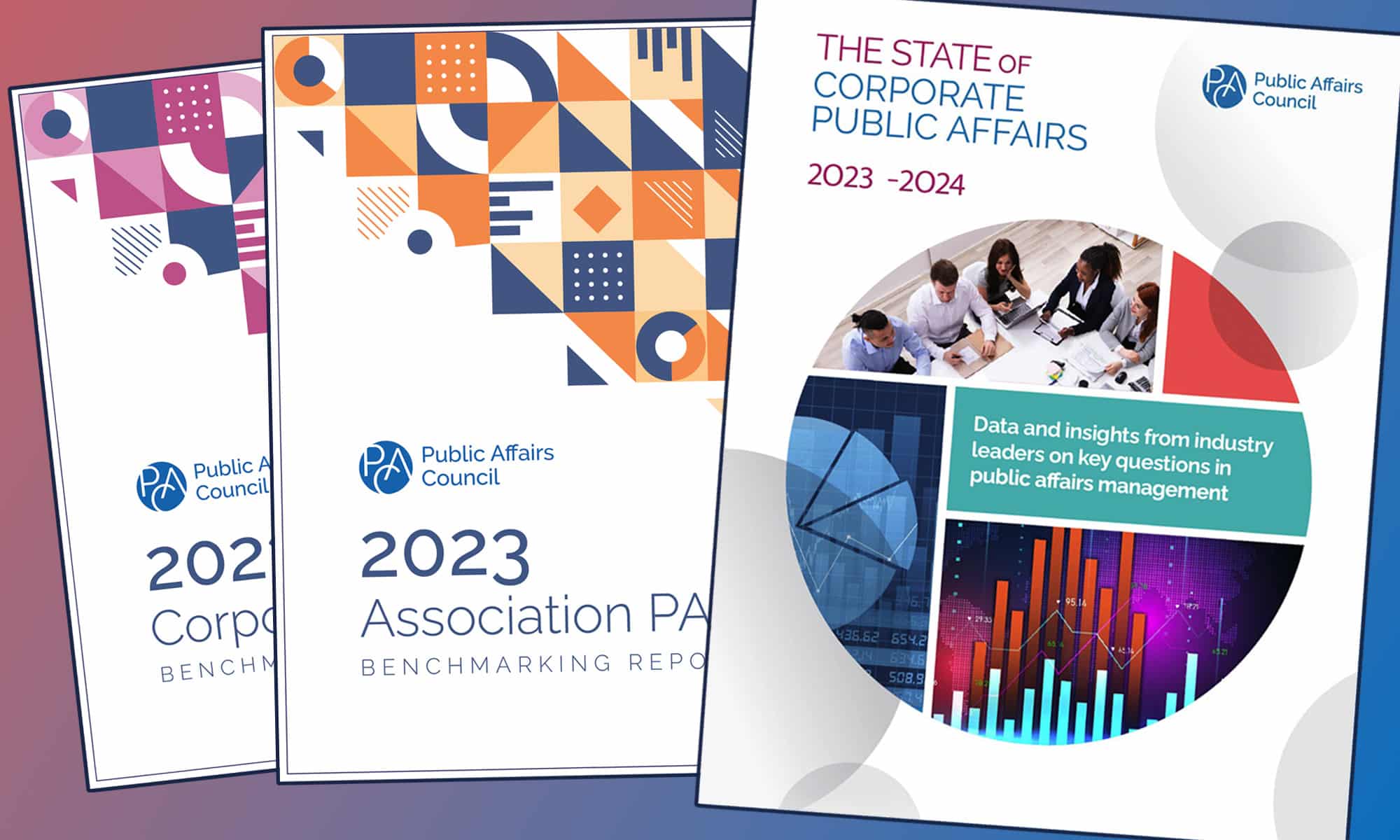Benchmarking Reports Reveal Public Affairs’ Growing Status
November 2023
Almost half (48%) of all public affairs executives report directly to their company’s CEO, an encouraging development revealed by the Council’s 2023 State of Corporate Public Affairs (SCPA) benchmarking report. It’s encouraging — and newsworthy — because it shows that public affairs professionals have opportunities to weigh in on decisions that affect companies’ business success, including risk management.
The findings, released this fall along with the Council’s 2023 Corporate and Association PAC Benchmarking Reports, also point to the fact that the public affairs function is continuing to prove its value as a strategic business asset. This status recognizes how the profession has emerged from a period of unprecedented stress to companies, their employees and their stakeholders. Helping their organizations weather the storms of the COVID-19 pandemic, the murder of George Floyd and its aftermath, and the Jan. 6 riot at the U.S. Capitol, public affairs departments and those who lead them have emerged stronger than ever.
“The three reports can be of incalculable value to public affairs executives and the organizations they represent,” says Council President Doug Pinkham. “Among other benefits, the findings can help our members identify emerging trends, benchmark their activities against those of their peers, identify areas of possible improvement and demonstrate value to stakeholders.”
Gaining Credibility
“In what appears to be a further demonstration of the fact that the public affairs function is gaining more and more credibility with the highest levels of their companies, 85% of those surveyed in the SCPA report say their staffing levels have remained the same or increased,” says Amy Meli, a senior director at the Council. “This is especially encouraging at a time when many companies have been forced to lay off employees and represents a significant improvement from the pandemic declines in staffing and budget in 2020, when 29% experienced a decrease in budget and 27% saw their staffing levels decline.”
This most comprehensive survey of corporate public affairs executives, the SCPA survey was conducted this past summer, and more than one third of the 150-plus respondents represent companies with more than $25 billion in global revenues and at least 35,000 global employees. About one quarter of respondents represent companies with revenues of no more than $5 billion and fewer than 10,000 employees. Almost 80% of the companies are headquartered in the U.S., with most of the others primarily based in Europe.
It is not surprising that companies’ growing recognition of the importance of public affairs comes at a time when a difficult political environment continues to be one of the profession’s greatest challenges. That has been the case for several years, but in the 2023 SCPA report, respondents were more specific about the nature of that difficulty: They are operating in an environment fraught with unprecedented levels of political polarization, where a company’s reputation can be battered severely as politically motivated allegations — fair or unfair, substantiated or utterly without foundation — are becoming commonplace.

Business PACs Are Stabilizing Force
In times like these, public affairs executives can learn a great deal about what is and isn’t effective and apply those insights as they craft their strategies and tactics. Here, too, both corporate and association PACs continue to play significant roles for the organizations they represent. And both are relying on fundraising methods that are increasingly well understood and efficiently implemented. Corporate PAC contributions have bounced back from 2021, when 81% paused contributions after the Capitol insurrection, and distributed $362 million to U.S. House and Senate candidates in the 2021-22 election cycle.
As significant as these dollars raised and contributed are to funding campaigns, perhaps business PACs’ most important impact is their role as a stabilizing force, striving conscientiously to be bipartisan. On average, 51% of association PAC contributions went to Republicans and 49% went to Democrats. The ratio for corporate PAC contributions was 53% to Republicans, 46% to Democrats and 1% to independents. The overwhelming majority of corporate PACs do not make contributions to super PACs, with only 4% choosing to go that route.
“The consistent bipartisan giving positions PACS as a healthy approach to encouraging sensible public policymaking at a time of worrisome polarization,” says Victoria Ellington, the Council’s senior manager, political engagement.
The corporate PAC survey was conducted this past spring, garnering responses from 137 federal PACs, with receipts ranging from less than $1,000 for newly formed PACs to $5.5 million for more established political involvement programs. Almost all (95%) are governed by boards of directors, and 96% make their contributions based on formal criteria.
Association PACs, meanwhile, are continuing to play a meaningful role in campaign finance, with participation rates increasing from 17% in the 2019-20 election cycle to 21% in the 2021-22 cycle. Encouraging, too, is that in-person and event-based fundraising has rebounded from the pandemic period, with 80% of association PACs conducting solicitations at annual meetings or trade shows. Virtual events, the go-to of the COVID-19 lockdown, have remained important, with educational webinars or teleconferences representing the most frequent benefit offered to PAC contributors. The Association PAC survey, like its corporate counterpart, was also conducted this past spring, gathering 71 responses from PACs with receipts ranging from $2,000 to just over $18 million.
Learn more about the State of Corporate Public Affairs and the PAC Benchmarking Reports.
“
The findings … also point to the fact that the public affairs function is continuing to prove its value as a strategic business asset. This status recognizes how the profession has emerged from a period of unprecedented stress to companies, their employees and their stakeholders.
More News & Resources
Whether you’re building cutting-edge campaigns, engaging communities on social, mobilizing advocates, or exploring the power of new AI tools, THIS is where the future of advocacy comes alive.


